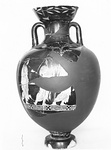Agora Object: Agora XXX, no. 22 | Chronology: | | Ca. 410 B.C. | | Deposit: | | B 15:1 | | Published Number: | | AV 30.22 | | References: | | Object: P 10554
|
Mended from many fragments with the missing pieces restored in plaster and painted, notably much of the wall under each handle and much of Side B. Ring on neck. Neck glazed on inside. Glaze abraded here and there. Chips on side of foot. H. 0.525; rest. diam. 0.125; diam. of mouth 0.172, of foot 0.125. P. E. Corbett, Hesperia 18, 1949, pls. 73, 74.
A--B, procession of youths, each wearing an olive wreath around his head and clad in a himation. On Side A, they walk past an olive tree. Figure 1 is completely preserved. The forearms, hands, and middle of figure 2 are missing. He looks back at 1, and the two carry a tray at hip level. Between figures 2 and 3 is the olive tree with fruit. All that remains of 3 is the top of his head, drapery over his right arm, lower drapery, and feet. He is an aulos-player (see below). Then comes a gap, where there was probably a fourth youth to balance the composition on this side. Side B preserves parts of three youths. The first (much of body and legs missing) moves to right, looking back, supporting a large amphora of Panathenaic shape on his left shoulder and steadying it with his right hand. Only the head of the next youth and the head and upper torso of the third remain. On side of mouth, olive sprig with fruit. At handle root, two addorsed palmettes. Below the figures, stopped-maeander pattern with checkerboard-squares. Inscribed on A, starting just above the forehead of the first youth:
above the head of the third:
on B, above the amphora:
Partial dilute glaze for hair. White (flaked): inscriptions; fruit of tree, wreaths and sprig.
For a discussion of the inscriptions and subject, see P. E. Corbett, Hesperia 18, 1949 [ pp. 298--351], pp. 306--308. J. Binder recognized that the third figure on Side A is a flute-player; she restored
as Χρυσο'γονος and identified him as the flute-player of Alkibiades (information conveyed by John Traill to Homer Thompson in a letter of February 13, 1986). For the name, see W. Pape-Benseler, Wörterbuch der griechischen Eigennamen, Brunswick1911, p. 1694:1: Χρυσο'γονος ; Kirchner in RE III, col. 2512, s.v. Χρυσο'γονος 2 (Chrysogonos).
For two youths carrying a tray on a Panathenaic amphora, see the pair on the obverse of Newcastle-upon-Tyne, Univ. no no. from the Group of Polygnotos (Paralip. 445, 128 bis, Matheson, Polygnotos, p. 476, cat. no. PGU 150).
Corbett saw that the drawing on 22 resembled that of the Talos Painter, but he concluded from the treatment of the hair and drapery that it is by another, less talented artist, a conclusion that seems correct, although one should mention specific similarities that draw 22 closer to the Talos Painter than to his contemporaries. For the furrowed brows of the youths, cf. Polydeukos on both sides of the Talos Painter's namepiece, Ruvo, Jatta 1501 (ARV2 1338, ---, 1; Paralip. 481, 1; Addenda 366). For the double median line on the right youth on Side B, cf. Poseidon and the Boreads on the namepiece and the two youthful warriors on Amsterdam inv. 2474 (ARV2 1339, 4; Addenda 367). For the profiles of our youths, cf. especially that of Athena on a fragment near the painter in Boston, M.F.A. 03.845 (ARV2 1340, 7).
|
